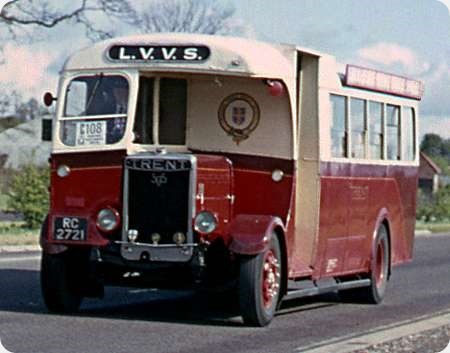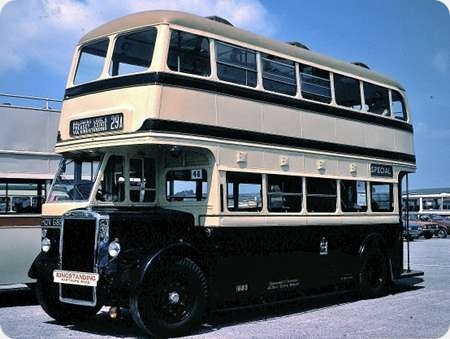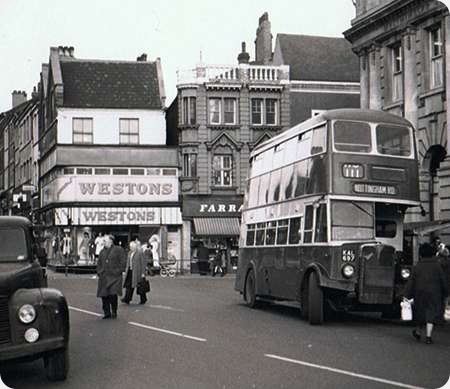Trent – SOS DON – RC 2721 – 321
Trent Motor Traction
1935
SOS DON
Brush B36F
Pictured on the HCVC Brighton Run in 1969 is RC 2721, an ex Trent SOS DON of 1935 with a Brush front entrance bus body that originally held 36 seats. SOS vehicles were favoured by the Trent and Northern companies during the 1930s, and the vehicle radiators were cast with the appropriate nameplates. No.321 ran for the Trent company until about 1953, when it then became a mobile booking office at Skegness, a popular holiday destination for coach trips from Derbyshire. In 1965 the vehicle passed into the hands of the Lincolnshire Vintage Vehicle Society, who rallied it in its unrestored state as shown in the photograph for several years, before retiring it with a (long term) view to full restoration in the early 1970s. Other pictures of RC 2721 may be seen on OBP here (scroll to bottom):- www.old-bus-photos.co.uk/
The extensive refurbishment/rebuilding programme is currently progressing well, as may be seen at this site:-www.lvvs.org.uk/
The SOS ON (“Onward”) type appeared in 1934 following the increase in maximum permitted length of single deckers to 27ft 6ins. The ON had the compact SOS 6 cylinder 5.986 litre RR2SB petrol engine which allowed the body to house 38 seats, and some retained the petrol unit right up to withdrawal in the early 1950s. A diesel version of the ON was immediately put in hand, and after trialling prototypes with the direct injection Leyland 8.6 litre engine and the indirect injection AEC 7.7 litre A171 engine, production adopted the AEC unit. The petrol ON thus became the diesel DON, but the AEC six cylinder engine was longer than the BMMO petrol, reducing the body capacity to 36 seats. The indirect injection engines in the BMMO DON fleet were converted to the A173 direct injection type in 1938, and this Trent example was likewise modified. By 1935, the SOS type presented a truly archaic appearance with the offset antiquated shape of radiator, narrow cab set entirely clear of the bonnet and different shape and depth to the mudguards (wings is hardly an appropriate description) on each side of the body. It compared unfavourably with the contemporary classic designs from Leyland, AEC and other major manufacturers. Whatever the mechanical merits, it was as if BMMO perversely set out to make its machinery as ungainly in appearance as possible. Not until 1938 did the more modern “AEC clone” radiator appear on BMMO SOS vehicles, and then only on double deck FEDDs. The first single deckers with the new style radiator were the SONs of 1939, as seen in this OBP page:- www.old-bus-photos.co.uk/
Photograph and Copy contributed by Roger Cox
12/03/17 – 17:37
I should have added that Potteries was another company that took SOS chassis. Surprisingly, Stratford Blue, a BMMO subsidiary from 1935, took none.
Roger Cox
13/03/17 – 16:34
UP 551, is a 1929 Northern General B37F Brush bodied SOS QL. It has been fully restored by Beamish Museum, and is shown on their website. Its in regular use transporting visitors around the site, and as Roger says in his posting, the Northern name is cast into the radiator. Whether it would be allowed onto a public highway is not known, but when this restoration is complete, it would be nice if somehow they could been seen together
Ronnie Hoye
13/03/17 – 16:35
Although Stratford Blue ran a very eclectic range of vehicles makes pre-war, it was a very loyal Leyland user post-war. I used to enjoy visiting there (and Birds)from time to time in the 1950’s and 60’s.
A pocket history of the company can be found here: //lths.lutsociety.org.uk/
Chris Hebbron
14/03/17 – 06:51
Ronnie – From photos on the web, it looks as if Northern General CN 2870 has ‘Northern’ on its radiator, UP 551 having Midland Red. See: https://tinyurl.com/he7e48f
Chris Hebbron
15/03/17 – 07:06
That’s a strange one Chris, having seen UP 551 in the flesh as it were, and in all the photos I’ve seen, it has Northern on the radiator, and yet, as can be clearly seen, in this case it has midland.
Explanations or theories anyone?
Ronnie Hoye
15/03/17 – 16:08
It certainly is a conundrum. The radiator shape and bonnet profiles of the two vehicles are quite different and it seems unlikely that they would be swapped over at any time.
Chris Hebbron
24/11/18 – 08:47
I have an AEC 171 engine with engine number A171RB 3952. It is Direct Injection which is puzzling me – your article describes converting 171 Indirect to 173 direct injections – was this an engine replacement or were the 171’s modified to 173 spec?
Steve Bruce
22/01/19 – 07:26
With regard to UP 551 carrying Midland Red on its radiator.
The radiators were cast with Midland Red in the header tank when constructed. The Northern plate is a separate casting fitted over the Midland Red logo. This arrangement was replicated during the restoration of UP 551.
The image was taken during a visit of a group from the Midlands hence the Northern plate had been temporarily removed.
Friends of Beamish
08/12/19 – 06:27
A tardy response to Steve’s query above, but AEC A171 indirect injection engines were (almost) universally converted to direct injection, at least in the UK, but I would imagine that the engine numbers remained unaltered.
Roger Cox
Quick links to the - Comments Page - Contact Page - Home Page



